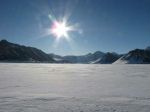
Anemometer which measures wind speed by the speed of rotation of 3 or 4 hemispherical or conical cups, each fixed to the end of a horizontal arm projecting from a vertical axis. See condenser-discharge anemometer, contact anemometer. Compare to bridled-cu ...

